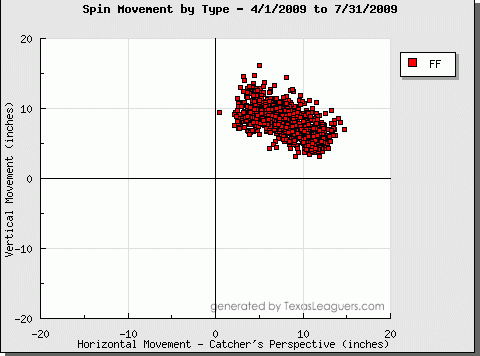I was kind of surprised by all of the talk about Zach Duke’s fatigue at the end of 2009 that’s popped up this week. I know Duke faltered at the end of the year, but he’d also been out-pitching his peripherals for most of the season and losing Jack Wilson and Freddy Sanchez certainly didn’t help the team defense and even his next to last start was the faux-controversial near shutout against the Dodgers to close PNC for the year. But Joe Kerrigan says fatigue and that’s something I think I can examine a little bit, so let’s see if we can find any real evidence of Zach Duke’s fatigue over the last two months of 2009.
We’ll split things up here the way Kerrigan does every time I hear him talking about Duke, right at the trade deadline. One quick and dirty way to measure Duke’s fatigue down the stretch should be fastball velocity. If he was tired, it’s possible that he wasn’t throwing as hard. Using Texas Leaguer’s PitchFX tool, we can compare all of Duke’s pitches over any span of time in 2009. In this case, we can see that Duke’s fastball actually increased in velocity a tick after August 1st when we compare it to the time period before the trade deadline. A change in fastball velocity from 88.8 to 89.2 isn’t big enough for us to assume that there’s some kind of significance in the given sample sizes, I don’t think, but it give us a pretty good idea that Duke didn’t lose anything off the pitch down the stretch last year.
Of course, there are a lot of ways fatigue can affect a pitcher. He could lose his control or lose the edge on his curveball or any number of things that might not show up in velocity. I still can’t get the raw PitchFX data, but Texas Leaguer does give graphs for each pitch over any split that we could care to look at. First, let’s take a look at the movement on Duke’s fastballs both before and after August 1st.


We can compare the average break numbers from those two links in the second paragraph, and they look pretty similar. There’s maybe a chance of a tenth of an inch or so, but nothing drastic, I don’t think. Visually, it looks like maybe a handful of his fastballs from the end part of the year had less downward break (essentially, they might’ve gotten left up in the zone), but it’s really hard to draw that conclusion definitvely here.
Now, his curveballs.


It’s not necessarily easy to see here, but the numbers do bear out a curveball that wasn’t quite as sharp after August 1st. Before the trade deadline, his curve averaged a 5.69 inch vertical drop with a 2.76 inch break away from left-handed hitters. After the deadline, those numbers dropped to 4.87 and 2.24. The contact numbers bear this out out as well. Before August 1st, Duke’s curve got a swing and miss 9.7% of the time and was put into play 15.9%, after August 1st it got a whiff only 4.2% of the time and was put in play 18% of the time.
FanGraphs measures pitch values and we can see that Duke’s curveball for the whole 2009 season was 7.4 runs above average, making it his second best pitch behind his changeup (which didn’t seem to appreciably differ in terms of break over our two time periods and so I’ve elected to not include those charts to keep this from getting even more bogged down than it is) , which measured 8.1 runs above average. Having those two pitches working is hugely important for Duke because his fastball, as you might’ve guessed, was nearly 20 runs below average last year. Take away one of them and … well, we all know what happens.
So was it fatigue down the stretch? I guess that’s as good a bet as any, though it could be something mechanical as well; if you check the pitch values for Duke’s whole career the big difference between 2009 and 2007-2008 is that Duke had his curve working (Aside: This is what Azibuck has been telling me for almost a full year now.), so essentially in August and September last year he turned into an older form of himself. It seems pretty clear that Kerrigan and company have the right idea in trying to figure out why that happened so they can prevent it from happening again.




















